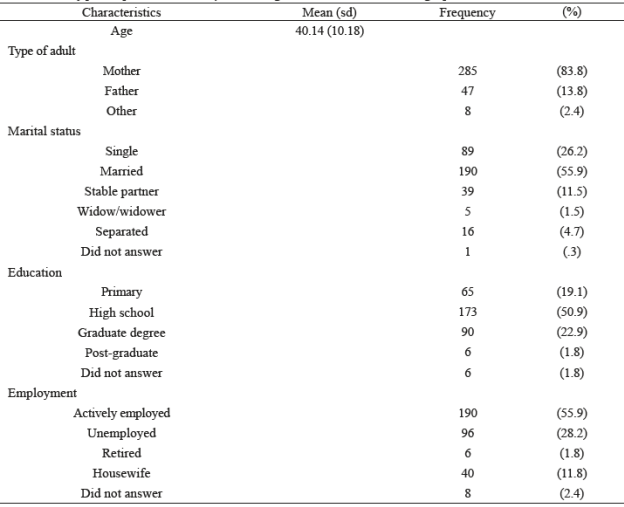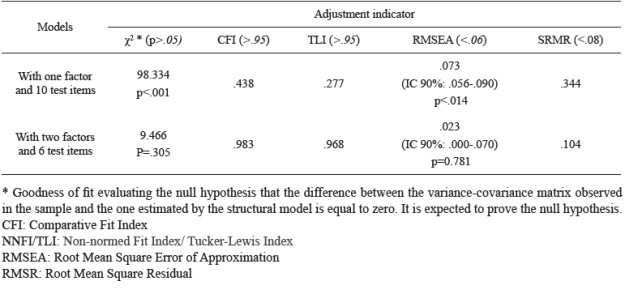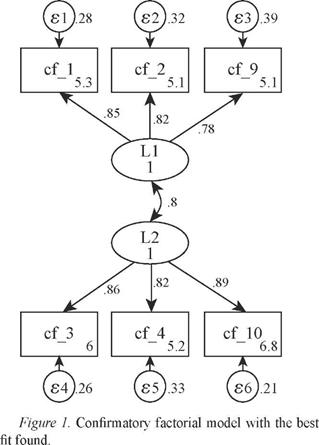INTRODUCTION
Academic interest in family communication goes back to the 1940s, although it was not until the 1970s when developments in this field began to emerge through contributions derived from various investigations (Galvin, 2015; Webb & Dickson, 2012).
According to Tesson and Youniss (1995), family communication is understood as the instrument that parents and children use to renegotiate their roles, develop their relationships and evolve towards greater mutuality and reciprocity. It is precisely through the process of socialization carried out within the family that children acquire the cultural components and social parameters that facilitate their social integration (Musitu & Cava, 2001). In this sense, family communication is part of the family context, an element recognized for its importance in child development due to the formative practices that are carried out through the structure and dynamics that facilitate learning experiences for social performance (Isaza & Henao, 2011).
The family is recognized as the main context of human development where the most significant learning for human beings is produced (Bronfenbrenner, 2005). The importance of communication within such context has necessarily been the focus of studies attempting to explain various complex social phenomena, such as family violence (Corsi, 1999), sexual abuse (Perrone & Nannini, 2000), and child abuse (Barcelata & Alvarez, 2005). Thus, the evaluation of family communication allows understanding the distinct factors associated not only with family functioning, but also those elements of the family climate that might help to explain the emotional evolutionary trajectories of its members. To this end, the evaluation of family communication is a vital tool in biopsychosocial intervention processes.
Communication and human development in the family
Broad consensus holds the family at the center of society, as the institution where the main learning of a human being is developed. The family bases its functioning on the interaction and meaning that its members give to the communicative processes (Gallego, 2006), thereby building their family reality through the conversation and co-creation of private lives and visions that they might have of the world. This yields space for developing communicative patterns where family members confront the need for individual expression versus communicative privacy.
These patterns, or family communication models, may vary throughout the family life cycle, though they are generally known to maintain a stable and predictable tendency (Koerner & Fitzpatrick, 2004). Likewise, family communication is recognized as a dynamic and bidirectional process in the sense that parents and children influence each other. According to Banovcinova and Levicka (2015), such communication may be influenced by two factor groups: (a) the combination of family characteristics, the person, and the social context, which includes family environment, interaction networks, norms, sociocultural context, and communication patterns; and (b) the characteristics of the communication process itself, such as the communicative mode (oral or written, for example), and the level and forms of communication. The first group is underscored by the work of Fitzpatrick and Ritchie (1993) which, in an attempt to describe the mutual influence between family communication and the family environment, created two concepts that have been fundamental in later studies. The first of these is orientation to the conversation, which is understood as the degree to which families create a climate that encourages their members to express opinions and share thoughts, feelings, and activities. Second is conformity orientation, which refers to the extent to which family communication fosters homogeneity in attitudes, values, and beliefs. Both dimensions have facilitated the understanding and study of functional aspects of the family in relation to communication.
The study on family communication
The evaluation of family communication has advanced significantly in recent decades, and scientific knowledge has expanded considerably around the impact that certain characteristics might have on human development.
There is evidence that a family with positive communication-that is, that generates clear and congruent messages, provides support and demonstrates affection and coping with conflict resolution skills-will be better able to face the challenges of home education. Meanwhile, a family with negative communication-that frequently uses criticism, denial of feelings, excessive conflict, and that does not know how to listen-will have less capacity to adequately address the education of children (Segrin & Flora, 2011; Smith, Freeman & Zabriskie, 2009).
Along these lines, the findings indicate that open and fluid family communication is associated with a series of positive results, both within the family and on an individual level. Specifically, positive family communication has a protective effect against criminal behavior in adolescents (Jiménez, Murgui, Estévez & Musitu, 2007; Kerr & Stattin, 2000), in conflict resolution (Girbau, 2002; Pérez & Aguilar, 2009), and in school adjustment (Estévez, Musitu & Herrero, 2005; Martínez, Musitu, Murgui & Amador, 2009).
However, there is little consensus regarding the results of a less fluid family communication. Some studies indicate that this may constitute a risk factor in the emotional development of children (Estévez, Herrera, Martínez & Musitu, 2006; Lambert & Cashwell, 2003), while other investigations have shown that, in the presence of poor family communication, conflicts are also less frequent between parents and adolescent children, presumably due to the avoidance of issues related to personal domains about the development and future of adolescents (Luna, 2012; Parra & Oliva, 2002).
Likewise, current research on family communication has extended to other multidisciplinary areas such as health (Kodali et al., 2015; Leenen et al., 2016; Myers, Fernandes, Arduser, Hopper, & Koehly, 2015; O'Toole et al., 2015), family satisfaction (Burns &Pearson, 2011; Levin, Dallago & Currie, 2012), and new technologies (Rudy, Dworkin, Walker & Doty, 2015; Wang et al., 2015).
International research on family communication has strong roots in Europe and the United States. Consequently, the results obtained are far from the social and cultural reality of Latin America. In particular, the situation in Chile shows that there have been significant advances in the validation of instruments oriented to specific areas within the family context, such as childhood and adolescence development (Lecannelier et al., 2014; Mathiesen, Merino, Herrera, Castro & Rodríguez, 2011; Quintana & Muñoz, 2010; Saldivia, Vicente, Valdivia & Melipillán, 2013), school context (Lecannelier et al., 2011; López, Bilbao, Ascorra, Moya & Morales, 2014), and general aspects of family functioning (Puschel, Repetto, Olga Solar, Soto & Gonzalez, 2012; Retamales, Behn & Merino, 2004; Zicavo, Palma & Garrido, 2012). However, there are few studies that have specifically addressed family communication (Santander et al., 2008), resulting not only in a knowledge gap but also in the lack of instruments that might allow the evaluation of this family characteristic within the national context.
Considering the importance of having a reliable instrument for measuring family communication in Chile, the aim of this study was to develop a version of the Spanish language adaptation of the Family Communication Scale (Sanz, Iraurgi & Martínez-Pampliega, 2002) which would serve the Chilean population. The Family Communication Scale has been applied in other international studies (Presa, 2015; Rivadeneira, 2013; Rivero & Martínez-Pampliega, 2010), and preliminary evidence suggests that it can be a useful tool for measuring family communication in Chile as well.
METHOD
Design
This research is part of the empirical-analytical knowledge construction approach. It is a descriptive-explanatory study on the psychometric properties and structural validation of the Family Communication Scale test.
Participants
The study population was based on the total enrollment of students in Primary Education between fourth to six grades in the city of Chillán, Chile, during the 2015 school year. Statistical data were provided by the Provincial Department of Education.
A total of5.244 students were distributed among 33 public and 35 privately subsidized ("semi-private") educational institutions. A total of six of these institutions were selected in a simple randomized manner, three for each type of administration (public and semi-private). Subsequently, a cluster sampling was performed, taking into account the fourth, fifth, and sixth grade baseline levels. In this way, the sample was composed of 340 mothers, fathers, and/or guardians. The sample size satisfies a one-dimensional or two-dimensional confirmatory factor solution with a power of 1-ß=.83 and a minimum factorial weight of X=.50 (Wolf, Harrington, Clark & Miller, 2013).
The main descriptive data of the population indicate that the average adult age was 40.14 years (sd = 10.18). Of the total number of participants, 83.8% were mothers, 13.8% were fathers, and 2.4% were other responsible adults. A primary education level was reported for 19.1% of the respondents, while 50.9% had a high school education, and 28.2% had a university or post-university level education.
Additionally, 55.1% of the sample was in an active or paid employment condition. (See table 1).
Instrument
The Family Communication Scale (FCS) was used to conduct research and data collection. It was elaborated by Barnes and Olson (1982) and adapted and validated in Spain by Sanz et al. (2002). The instrument in its Spanish version shows a coefficient of internal consistency- Cronbach's alpha .88-and a test-retest and intra-class correlation of 0.88. In terms of concurrent validity, this scale was correlated with related theoretical constructs of the Social Climate in the Family Scale (Moos, Moos & Trickett, 1987), indicating a positive correlation with the communication dimension (0,68) and expressiveness (0.59), while manifesting a negative correlation with the conflict dimension (-0.37). These associations indicate the convergent and divergent validity of the scale in its Spanish version (Sanz et al., 2002).
The objective of the scale is to assess the communication that occurs in the family by gathering important data such as the level of openness or freedom to exchange ideas, information and concerns between generations, confidence and honesty experienced, and the emotional tone of the interactions.
It is an instrument that by its brevity and simplicity allows for individual and group application. It consists of 10 items on a one-dimensional scale that values positive communication skills such as clear and congruent messages, empathy, supportive phrases, and effective problem-solving skills. The application time is approximately 10 minutes. Each item is scored on a scale with five response options: (1) does not describe my family; (2) only slightly describes my family; (3) sometimes describes my family; (4) generally describes my family; (5) describes my family very well.
The total score is obtained from the sum of the scores. The minimum possible score is 10 points, and the maximum possible score is 50 points. A higher score indicates a better level of family communication.
In the present study, the 10 items were subjected to linguistic relevance analysis by three independent judges, after which no changes were made to the scale.
Procedure
Both families and school principals received information about the objectives of the study, and families were asked for their informed consent to voluntary participation.
Prior to the application of the instrument, the interviewers underwent supervised training in order to standardize the data collection method, which included how to administer the instrument. The application was carried out collectively in the parent meetings carried out by the educational institutions.
RESULTS
The conformation of the instrument constructs with exploratory factor analysis was described according to the principal axis method, given that the data did not present multivariate normality, as measured by the Doornik-Hansen test (Chi2= 1543.012, 20 gl, p<.001). Data were rotated using the Varimax method, which facilitated the definition of the constructs and minimized the number of reagents that have high saturations in each factor. The feasibility of performing the exploratory factor analysis was evaluated with the Bartlett sphericity test and the Kaiser-Meyer-Olkin coefficient (KMO). The extracted constructs obeyed the application of three criteria: (a) value greater than 1.00, (b) graphic method elbow, and (c) explained variance (60% or more). The factor solution needed to include at least three items per construct.
After learning about the number of constructs that the instrument contained, a Confirmatory Factor Analysis was applied to evaluate whether the items were adequately correlated with the constructs, the level of relationship between those constructs, the magnitude of the measurement errors, and the overall fit of the specified model to the sample data. A model of structural equations was used with the Asymptotic Free Distribution method. All estimates were shown as standardized values.
There is evidence of validity by confirmatory factor analysis when one accepts the null hypothesis that the difference between the variance-covariance matrix observed in the sample and the one estimated by the structural model is equal to zero. The significance level of the scale in this study was 0,05. Given that this hypothesis test is based on sample size, the following validity indicators are also confirmatory validity tests: Root Mean Square Residual (RMSR)<.08), Root Mean Square Error of Approximation (rMRSEA)<0,08), Non-normed Fit Index/ Tucker-Lewis Index (NNFI/TLI>,95), and Comparative Fit Index (CFI>.95) (Arias, 2008; Hooper, Coughlan & Mullen, 2008; Ruiz, Pardo & San Martín, 2010; Stage, King, Nora & Barlow, 2006).
Table 2 presents the mean scores and the variability of each item that composes the scale as applied to the sample of Chilean adults. Results show that the correlations between the item score and the total scale were greater than .60 except for item CF_5 which presented a value of .57. Regarding the Cronbach scale, when item CF_5 is removed, values greater than .90 are found. Finally, the factor of sample adequacy for each item which determines the level of correlation of the item with a given construct, shows values higher than .90.
Table 2 Summary measures, item-total correlation, and alpha coefficient if the item and MSA coefficient of all items of the scale are deleted.
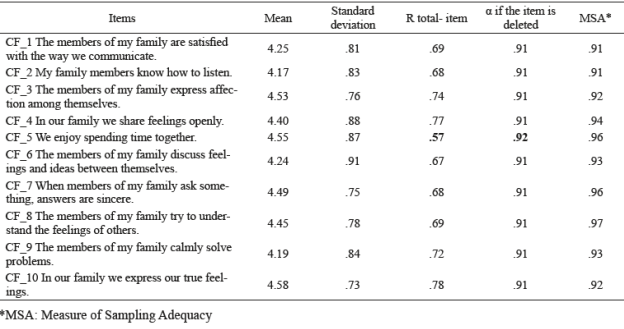
To evaluate the empirical feasibility of constructing an exploratory factor analysis, a statistically significant Bartlett sphericity test was employed, where results of x2= 1980.786, 45 gl, p<.001 were obtained in addition to the KMO coefficient (.93). Both tests checked the presence of the constructs being analyzed.
Since the Spanish language version of the scale used to generate this study is one-dimensional (Sanz et al., 2002), a factorial analysis was applied for one construct. Results found that this sample explains 54.2% of the variance, with commonalities superior to .50, with the exception of items CF_6 (.495) and CF_5 (.354). Cronbach's alpha for the 10 items on the scale was .919 (See Table 3 Solution A).
Table 3 Exploratory factorial solution with main axes (rotation varimax) of the test items that form the scale in a sample of adults (n=340).
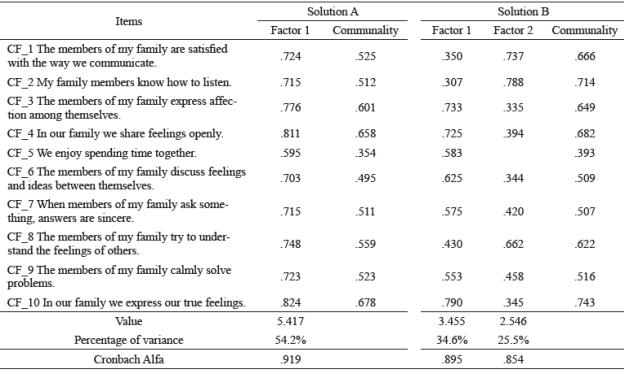
Furthermore, a second factorial solution was generated, this time with two constructs (Table 3, Solution B ), where it was found that these two accounted for 60.1% of the variance, showing a single item test with a community value of less than .50 (CF_5), and factorial weights that differ between the two constructs (with the exception of CF_8 and CF_7); however, alpha values higher than .80 were found in both constructs. A third factorial solution (unpublished) was found, which explained 60.01% of the variance, where the third factor was composed only by item CF_6. Yet, for this reason it was rejected as a factorial option for testing with confirmatory factor analysis. In conclusion, a confirmatory factorial solution was tested with two constructs, starting with 10 test items, with the suspicion that items CF_5, CF_6, CF_7, and CF_8 did not contribute to a solution with sufficient statistical "goodness of fit."
From these two exploratory factor solutions, the statistical fitness of the structural equation models is presented in Table 4. It was found that the factorial solution with two factors and six test items presents the best fit (deleted one-by-one) in comparison with the results based on the unifactorial solution and with two factors and 10 test items.
Figure 1 presents the factorial weights (coefficients) of the structural equations obtained for the version with two factors and six test items that was proven to produce the best statistical fitness. Values above .75 were found, with typed errors very close to zero, producing z-scores greater than 1.96 with p <.001 and a covariance between the two test items of .80.
DISCUSSION
The aim of this study was to validate the Spanish language version of the Family Communication Scale in Chilean population. Results showed that a factorial solution with two factors and six test items presents the best fit, suggesting that this instrument allows differentiation in the Chilean sample between the emotional/affective components of communication and the components associated with more general aspects of family communication, such as conflict resolution or listening skills.
This evidence marks a difference with the original scale, which relies on a one-dimensional solution. In this regard, the results of this research agree with the theoretical assumptions of Banovcinova and Levicka (2015), through which communication is influenced precisely by these two differentiated elements: characteristics of the family (family climate), and the characteristics of the communication process. Indeed, in this adaptation of the instrument, one can see a grouping of those constructs associated with the category of orientation to conversation that stands out from the work of Koerner y Fitzpatrick (2002). In this case, questions were focused on determining the degree to which families create a climate that encourages their members to participate freely in interactions ("members of the family express affection between themselves"), and also of those that point to more general elements of family communication, such as conflict resolution or the ability to listen ("family members know how to listen").
Undoubtedly, this difference in the instrument with respect to the Spanish language version might be explained by the cultural characteristics between both populations. Family communication is a process in which context is an important element for consideration. The environmental context includes historical, social, and physical aspects so that family communication will be understood within a system which is socially learned and understood (Gallego, 2006), thus making it inseparable from family relations and communicational processes of normative cultural contexts based on particular realities. This is a phenomenon that has been thoroughly addressed by several authors from various areas of general linguistic research (Briz, 2005; Charaudeau, 2012; Puga, 2012).
Limitations to the present study are given by the characteristics of the sample, which may not be representative of the rural or more distant areas of the national territory, where it is possible that the population has other distinctive sociocultural characteristics. Likewise, the study did not consider the inclusion of a third educational alternative in the country, such as fully private educational institutions, which might eventually give greater variability to the results. In fact, future research could encompass greater population diversity in order to verify the behavior of the scale in other social contexts.
Understanding family communication as a process of mutual influence among its members that takes place throughout the entire life-cycle of a human being implies recognizing that it is an essential element in the development and evolutionary trajectory of an individual. The study of family communication facilitates, therefore, not only the understanding of the individual's interaction in relation to the family, but also how the family relates to the social environment. Therefore, making advancements in understanding the interactive processes that take place within the family is a constant challenge for various disciplines and professionals.
Along these lines, having a family communication scale validated in the Chilean national context will allow multidisciplinary teams working in various fields related to prevention, promotion, and intervention in the family area to have an instrument that can guide professional practices, and also facilitate the development of future research to achieve greater knowledge on the subject. In this way, the current empirical gaps in the Chilean national context might be overcome, contributing in turn to a greater awareness of the issue in Latin America.











 texto en
texto en 

